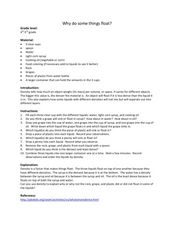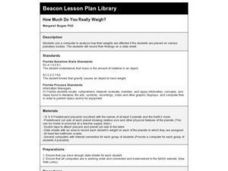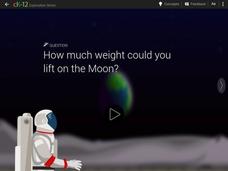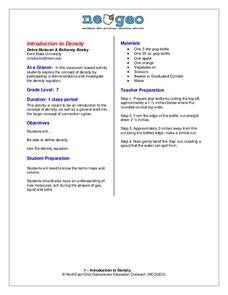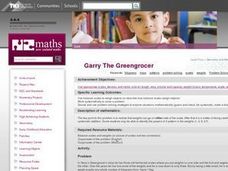Curated OER
Simple Machines IV - Levers
The lever is an everyday simple machine. Youngsters learn the principles of levers and explore their many uses. Groups of pupils perform a simple lab where they lift objects with a fulcrum while placing the load in a variety of...
Curated OER
Why Do Some Things Float?
Students recognize that density determines whether objects sink or float. In this sink or float lesson, students experiment with plastic in three liquids. students drop their objects into the liquids and observe and record their results.
Curated OER
Measuring Up
Students examine and discuss a variety of ways to measure length, capacity, and weight. They estimate and measure a pencil's length using Unifix cubes, estimate and fill a measuring cup with Unifix cubes, and weigh a calculator in a...
Curated OER
Displacement and Density
High schoolers explore displacement. In this displacement and density lesson plan, pupils find the volume of irregular shaped objects. Afterward, they determine the volume of containers. They compute the amount of water displacement.
Texas State Energy Conservation Office
Investigation: Kinetic and Potential Energy
A well-developed lab sheet guides physical science learners through an investigation of kinetic and potential energy. In small groups, collaborators discover whether or not the ramp height or mass of an object has an effect on the...
Curated OER
Making Predictions About Measurement
Upper graders experiment with measurement. They estimate the length, volume, and weight of various objects, then rotate through stations making predictions concerning measurements and then testing their predictions.
Virginia Department of Education
Average Atomic Masses
Facilitate learning by using small objects to teach the principles of atomic mass in your science class. Pupils determine the average mass of varying beans as they perform a series of competitive experiments. They gather data and...
Messenger Education
Mission: Possible—How Can We Plan an Exploration of Another World?
An astronaut's spacesuit weighs 280 pounds and takes 45 minutes to put on — that's a serious suit! The second activity of a three-part series allows pupils to see all that goes into space exploration. Through simulations, groups analyze...
Teach Engineering
May the Force Be with You: Weight
Too much material will weigh you down. The sixth segment in a series of 22 highlights how weight affects a plane. Pupils learn that engineers take the properties of materials, including weight, when designing something.
Illustrative Mathematics
Writing Constraints
Use this resource to present your number crunchers with how to write a constraint equation and to determine viable solutions. The price of an object limits the amount that can be purchased. The speed at which you walk limits the number...
Curated OER
Measuring Weight, Mass, and Capacity
Second graders investigate the concept of measuring weight, mass, and capacity. In this measurement worksheet, 2nd graders compare items using the words "more than" or "less than." They predict whether an item weighs more or less than a...
Curated OER
Pounds
In this mathematics worksheet, 1st graders identify which items pictured weighs more or less than a pound. Then they circle the objects that weigh more and place an X on the object that weigh less than a pound.
Curated OER
Weight
In this estimating weights of objects activity, students observe objects, estimate the metric measurements, and choose the best answer. Students solve 9 problems.
Curated OER
How Much Do You Really Weigh?
Sixth graders check to see how their weights differ if they weighed themselves on different planets. They record their findings on a data sheet.
CK-12 Foundation
Astronaut Training Chamber
Most people realize they would weigh less if they were on the moon, but does it change how much weight you could lift if you were on the moon? Scholars adjust the mass of an object to be lifted and select between four different locations...
Curated OER
Worksheet 26: Vector Force
In this vector force worksheet, students determine the total velocity of objects, the displacement direction, and vector movement. This two-page worksheet provides a total of six multi-step problems.
Curated OER
Solving Simple Addition and Subtraction Equations Using Fact Families
Students explore addition fact families. In this addition and subtraction fact family math lesson, students click and drag objects on the Smart Board to create visual representations of fact families. Students use fact family strategies...
NorthEast Ohio Geoscience Education Outreach
Introduction to Density
Seventh grade scientists weigh in on the concept of density. In a nutshell, they participate in the following activities:
Measurement of the mass and volume of fruit in order to compare densities
Measurement of the mass of oil and water...
Curated OER
Gravity Exploration
In this space worksheet, students complete each of the statements related to weight on the moon. Then they create three questions that could be answered after completing the lab activity.
Curated OER
Garry The Greengrocer
Fourth graders are introduced to the problem by weighing objects on the balance scales. Use weights in both pans. (If you don't have access to scales use 2 containers and a child acting as the balance.) They then listen to the problem...
Curated OER
Applied Science - Science and Math Post Lab
Students utilize a balance scale. In this applied science lesson, students compare the weights of two objects using an elementary balance scale. Students balance the scale with weights to find how heavy an object is.
Physics LAB
Freebody Diagrams #1
In this free body diagrams worksheet, learners answer 19 questions about given diagrams including the forces exerted on objects, the magnitude of acceleration, and the tension in strings.
Curated OER
Grams and Kilograms
Fourth graders participate in scavenger hunts for objects that weigh a gram and a kilogram. In this metric measure instructional activity, 4th graders use a spring scale to measure objects they believe weigh a gram and a kilogram....
Curated OER
Making It Balance
Students listen to story, "The 100-Pound Problem," compare their weight with character in story, and weigh different classroom items using nonstandard units and standard units. They experiment with different items that can make scale...



